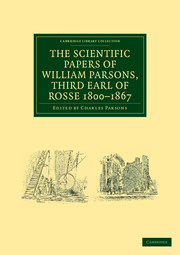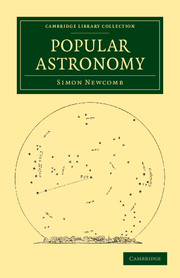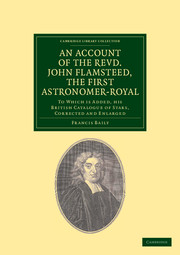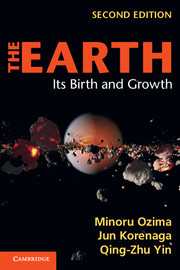Refine listing
Actions for selected content:
16950 results

The Scientific Papers of William Parsons, Third Earl of Rosse 1800–1867
-
- Published online:
- 05 May 2012
- Print publication:
- 03 November 2011
- First published in:
- 1926

Popular Astronomy
-
- Published online:
- 05 May 2012
- Print publication:
- 24 October 2011
- First published in:
- 1878

An Account of the Revd. John Flamsteed, the First Astronomer-Royal
- To Which Is Added, his British Catalogue of Stars, Corrected and Enlarged
-
- Published online:
- 05 May 2012
- Print publication:
- 03 November 2011
- First published in:
- 1835

The Earth
- Its Birth and Growth
-
- Published online:
- 05 May 2012
- Print publication:
- 12 April 2012
2 - Discovery
-
- Book:
- Maser Sources in Astrophysics
- Published online:
- 05 May 2012
- Print publication:
- 26 April 2012, pp 33-75
-
- Chapter
- Export citation
References
-
- Book:
- Maser Sources in Astrophysics
- Published online:
- 05 May 2012
- Print publication:
- 26 April 2012, pp 392-414
-
- Chapter
- Export citation
11 - Epilogue: statistics and our Universe
-
- Book:
- Practical Statistics for Astronomers
- Published online:
- 05 June 2012
- Print publication:
- 26 April 2012, pp 291-315
-
- Chapter
- Export citation
Foreword to first edition
-
- Book:
- Practical Statistics for Astronomers
- Published online:
- 05 June 2012
- Print publication:
- 26 April 2012, pp xiii-xiv
-
- Chapter
- Export citation
Foreword to second edition
-
- Book:
- Practical Statistics for Astronomers
- Published online:
- 05 June 2012
- Print publication:
- 26 April 2012, pp xv-xvi
-
- Chapter
- Export citation
Appendix D - Change of variables in integration
-
- Book:
- Maser Sources in Astrophysics
- Published online:
- 05 May 2012
- Print publication:
- 26 April 2012, pp 369-370
-
- Chapter
- Export citation
7 - Data modelling and parameter estimation: advanced topics
-
- Book:
- Practical Statistics for Astronomers
- Published online:
- 05 June 2012
- Print publication:
- 26 April 2012, pp 151-181
-
- Chapter
- Export citation
Note on notation
-
- Book:
- Practical Statistics for Astronomers
- Published online:
- 05 June 2012
- Print publication:
- 26 April 2012, pp xvii-xx
-
- Chapter
- Export citation
Index
-
- Book:
- Maser Sources in Astrophysics
- Published online:
- 05 May 2012
- Print publication:
- 26 April 2012, pp 415-419
-
- Chapter
- Export citation
9 - Sequential data – 1D statistics
-
- Book:
- Practical Statistics for Astronomers
- Published online:
- 05 June 2012
- Print publication:
- 26 April 2012, pp 230-261
-
- Chapter
- Export citation
1 - Decision
-
- Book:
- Practical Statistics for Astronomers
- Published online:
- 05 June 2012
- Print publication:
- 26 April 2012, pp 1-19
-
- Chapter
- Export citation
3 - Statistics and expectations
-
- Book:
- Practical Statistics for Astronomers
- Published online:
- 05 June 2012
- Print publication:
- 26 April 2012, pp 55-70
-
- Chapter
- Export citation
Appendix J - Matrices
-
- Book:
- Maser Sources in Astrophysics
- Published online:
- 05 May 2012
- Print publication:
- 26 April 2012, pp 385-386
-
- Chapter
- Export citation
4 - Observations of masers
-
- Book:
- Maser Sources in Astrophysics
- Published online:
- 05 May 2012
- Print publication:
- 26 April 2012, pp 113-155
-
- Chapter
- Export citation
5 - Hypothesis testing
-
- Book:
- Practical Statistics for Astronomers
- Published online:
- 05 June 2012
- Print publication:
- 26 April 2012, pp 92-125
-
- Chapter
- Export citation
Appendix G - Local standard of rest
-
- Book:
- Maser Sources in Astrophysics
- Published online:
- 05 May 2012
- Print publication:
- 26 April 2012, pp 377-377
-
- Chapter
- Export citation
